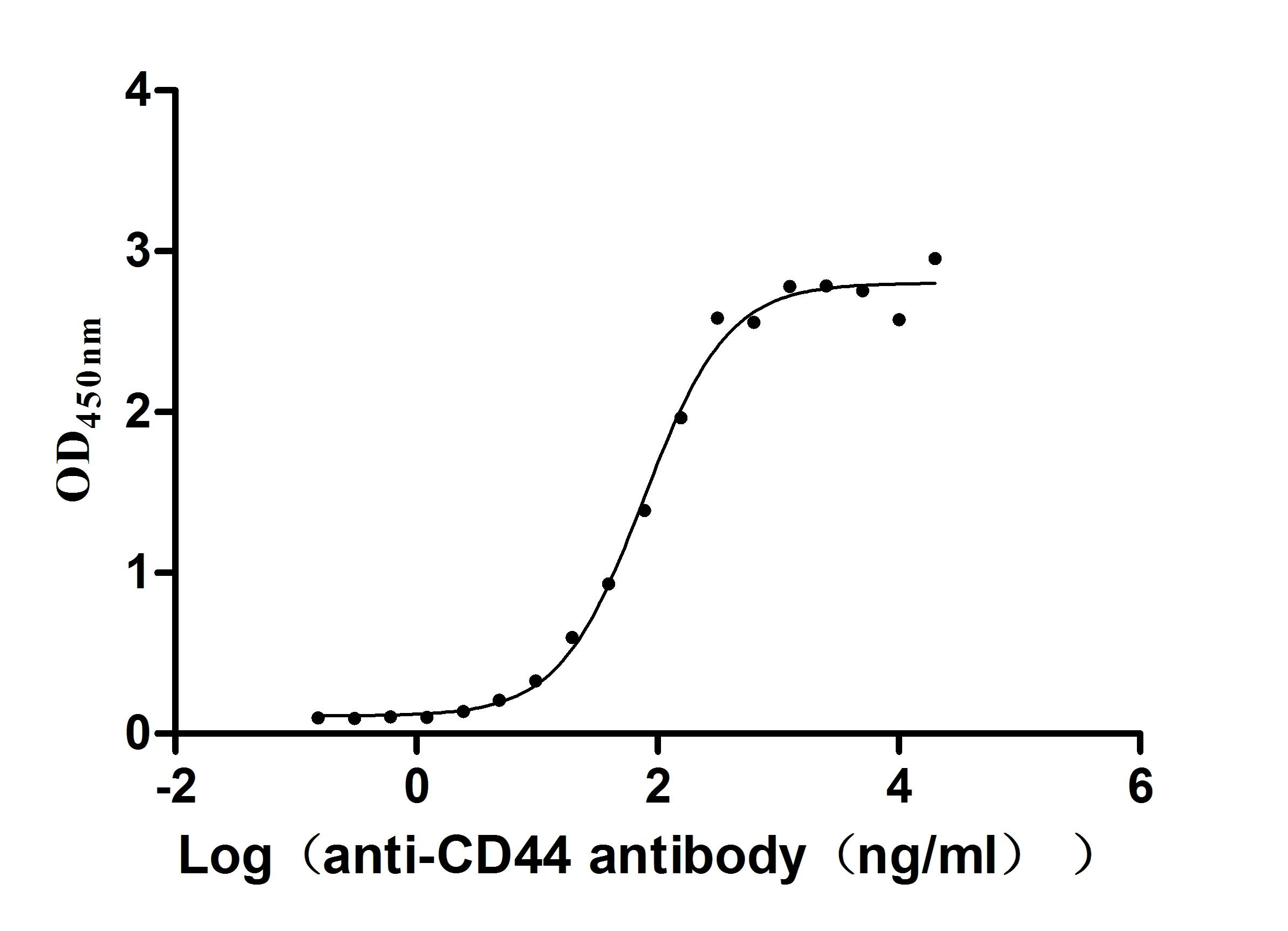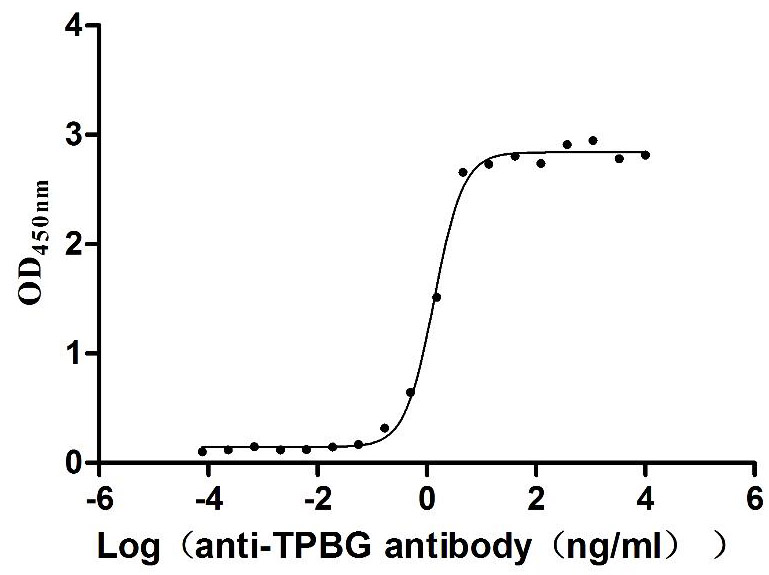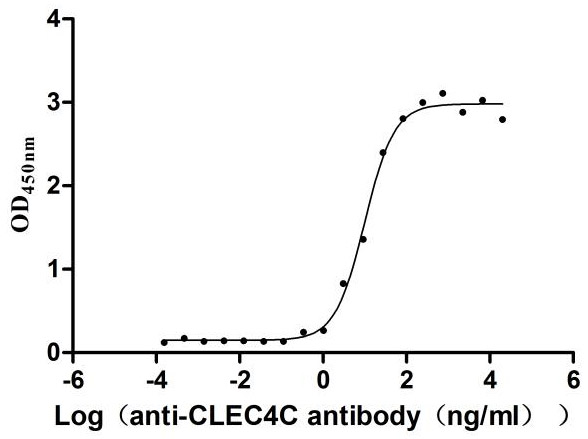Recombinant Rat Erythropoietin (Epo)
-
中文名稱:大鼠Epo重組蛋白
-
貨號:CSB-YP007743RA
-
規(guī)格:
-
來源:Yeast
-
其他:
-
中文名稱:大鼠Epo重組蛋白
-
貨號:CSB-EP007743RA
-
規(guī)格:
-
來源:E.coli
-
其他:
-
中文名稱:大鼠Epo重組蛋白
-
貨號:CSB-EP007743RA-B
-
規(guī)格:
-
來源:E.coli
-
共軛:Avi-tag Biotinylated
E. coli biotin ligase (BirA) is highly specific in covalently attaching biotin to the 15 amino acid AviTag peptide. This recombinant protein was biotinylated in vivo by AviTag-BirA technology, which method is BriA catalyzes amide linkage between the biotin and the specific lysine of the AviTag.
-
其他:
-
中文名稱:大鼠Epo重組蛋白
-
貨號:CSB-BP007743RA
-
規(guī)格:
-
來源:Baculovirus
-
其他:
-
中文名稱:大鼠Epo重組蛋白
-
貨號:CSB-MP007743RA
-
規(guī)格:
-
來源:Mammalian cell
-
其他:
產(chǎn)品詳情
-
純度:>85% (SDS-PAGE)
-
基因名:Epo
-
Uniprot No.:
-
別名:EpoErythropoietin
-
種屬:Rattus norvegicus (Rat)
-
蛋白長度:Full Length of Mature Protein
-
表達區(qū)域:27-192
-
氨基酸序列APPR LICDSRVLER YILEAKEAEN VTMGCAEGPR LSENITVPDT KVNFYAWKRM KVEEQAVEVW QGLSLLSEAI LQAQALQANS SQPPESLQLH IDKAISGLRS LTSLLRVLGA QKELMSPPDA TQAAPLRTLT ADTFCKLFRV YSNFLRGKLK LYTGEACRRG DR
-
蛋白標簽:Tag?type?will?be?determined?during?the?manufacturing?process.
The tag type will be determined during production process. If you have specified tag type, please tell us and we will develop the specified tag preferentially. -
產(chǎn)品提供形式:Lyophilized powder
Note: We will preferentially ship the format that we have in stock, however, if you have any special requirement for the format, please remark your requirement when placing the order, we will prepare according to your demand. -
復溶:We recommend that this vial be briefly centrifuged prior to opening to bring the contents to the bottom. Please reconstitute protein in deionized sterile water to a concentration of 0.1-1.0 mg/mL.We recommend to add 5-50% of glycerol (final concentration) and aliquot for long-term storage at -20℃/-80℃. Our default final concentration of glycerol is 50%. Customers could use it as reference.
-
儲存條件:Store at -20°C/-80°C upon receipt, aliquoting is necessary for mutiple use. Avoid repeated freeze-thaw cycles.
-
保質(zhì)期:The shelf life is related to many factors, storage state, buffer ingredients, storage temperature and the stability of the protein itself.
Generally, the shelf life of liquid form is 6 months at -20°C/-80°C. The shelf life of lyophilized form is 12 months at -20°C/-80°C. -
貨期:Delivery time may differ from different purchasing way or location, please kindly consult your local distributors for specific delivery time.Note: All of our proteins are default shipped with normal blue ice packs, if you request to ship with dry ice, please communicate with us in advance and extra fees will be charged.
-
注意事項:Repeated freezing and thawing is not recommended. Store working aliquots at 4°C for up to one week.
-
Datasheet :Please contact us to get it.
相關產(chǎn)品
靶點詳情
-
功能:Hormone involved in the regulation of erythrocyte proliferation and differentiation and the maintenance of a physiological level of circulating erythrocyte mass. Binds to EPOR leading to EPOR dimerization and JAK2 activation thereby activating specific downstream effectors, including STAT1 and STAT3.
-
基因功能參考文獻:
- Increases in plasma erythropoietin and erythropoietin receptor activation are mechanisms implicated in the increase of plasma FGF23 in acute kidney injury. PMID: 29395333
- Epo and Epo-Receptor are expressed in the spiral ganglion neurons (SGNs) of the inner ear of the rat, and Epo adenovirus vector (AdEpo) can decrease the spontaneous apoptosis of SGNs, which may provide a basis for the prevention or alleviation of sensorineural hearing loss. PMID: 29436578
- EPO administration increased TMPRSS6 content in the plasma membrane-enriched fraction of liver homogenate; in iron-pretreated rats, this increase was abolished. The results confirm that iron pretreatment prevents the EPO-induced decrease in liver Hamp expression. PMID: 28282554
- Protection of erythropoietin markedly attenuated pyroptosis and apoptosis of neurons exposed to sevoflurane via Erk1/2-Nrf2/Bach1 signal pathway. PMID: 28189515
- protective effects of EPO may be mediated by nitric oxide and the expression of different NOS enzymes, especially iNOS isoform PMID: 28087117
- EPO receptor ligand dimeric peptides AF41676 and AF43136 administered before reperfusion are able to reduce infarct size in a rat model of AMI. PMID: 27521836
- The present study aimed to determine the expression of erythropoietin (EPO) and the EPO receptor (EPOR) in spiral ganglion neurons (SGNs) in the inner ear of rats of various ages, and the associated neuronal apoptosis and hearing alterations. PMID: 27959434
- Study shows that erythropoietin reduced chemokine CCL3 mRNA expression in rat cerebellar neuron-enriched preparations during neuroinflammation. PMID: 26178913
- Taken together, our results reveal that EPO and cEPO mediate MEF2 target gene expression via the regulation of HDAC5 phosphorylation at Ser259/498, and suggest that HDAC5 could be a mechanism contributing to the therapeutic actions of EPO and cEPO. PMID: 26777998
- this study is the first to elucidate the detailed mechanism by which AhR plays an indispensable role in the suppression of HIF activation by IS. PMID: 26561638
- the hypercapnic hypoxia causes maximum activation of the synthesis and accumulation of erythropoietin HIF-1alpha, and permissive hypercapnia enhances their content more than hypoxic exposure. PMID: 26852593
- Results of the present study demonstrate the neuroprotective, anti-inflammatory and antioxidant effects of EPO in a rotenone-induced neurodegenerative animal model. PMID: 25464888
- Vitamin A deficiency leads to ineffective erythropoiesis by the down-regulation of renal erythropoietin expression in the kidney, resulting in erythrocyte malformation and the consequent accumulation of the heme group in the spleen. PMID: 24998947
- EPO partially rescued insulin-stimulated AKT activation, reduced oxidative stress, and restored heat-shock protein 72 expression in soleus muscles. PMID: 25767056
- Results showed that the inhibitory effects of TNFa on the hypoxia-induced upregulation of erythropoietin expression are mediated primarily by HIF-2a rather than HIF-1a PMID: 25283246
- Data suggest a potential positive effect of erythropoietin (EPO) on hepatocytes (HCs) proliferation during liver regeneration after a partial hepatectomy. PMID: 24928528
- HIF-1alpha/EPO hypoxic signal transduction may initiate hippocampal neurogenesis following hypoxia-ischemia PMID: 25935977
- The present study suggests that EPO can exert a cardioprotective effect on DOX-induced cardiotoxicity which may be associated with improving MMP-2/TIMP-2 imbalance. PMID: 24685074
- Epidermal growth factor and erythropoietin infusion accelerate functional recovery in combination with rehabilitation. PMID: 24763928
- In IN-IC cells, hypoxia increased mRNA expression of erythropoietin, erythropoietin concentration in the medium and protein expression of HIF PHD2. PMID: 24832733
- After 2-weeks of hypoxia, erythropoietin transcripts and erythropoietin plasma levels were significantly increased in hypoxic animals compared with control animals. PMID: 24524370
- rMSCs transplantation could be a new therapy for degenerative retinal diseases since it can protect and rescue RPE and retinal neurons, while EPO gene modification to rMSCs could be an even better option. PMID: 23971737
- Erythropoietin prevents lymphoid apoptosis but has no effect on survival in experimental sepsis. PMID: 23728385
- EPO induces the expression of myelin genes in oligodendrocytes and this effect requires the presence of EPOR. PMID: 23821361
- EPO significantly suppresses the enhanced apoptosis and activity of caspase 3 that are induced by 6-hydroxydopamine. PMID: 22294054
- 11 weeks of endurance training increased erythrocyte deformability. Epo and EpoR may contribute to the decreased morphological index and deformability indicator in erythrocytes during endurance training in rats. PMID: 22495316
- EPO potently protects against cardiopulmonary bypass-induced acute renal injury by inhibiting expression of NF-kappaB p65 and inflammatory response. PMID: 22659586
- EPO induces a significant decrement in the ohmic airway resistance. PMID: 22766248
- Pyruvate activation of the hypoxia-inducible factor-1alpha-EPO signaling cascade in neurons and glia could protect the brain from ischemia-reperfusion injury PMID: 22282883
- Ligustilide exerts neuroprotective effects against I/R injury by promoting EPO transcription via an ERK signalling pathway and inhibiting RTP801 expression. PMID: 21410687
- A protective cascade for erythropoietin (EPO) relies upon modulation of Wnt1, Akt1, FoxO3a, GSK-3beta, beta-catenin, and mitochondrial apoptotic pathways for the development of new strategies against DM vascular complications. PMID: 21443457
- Our work identifies novel pathways for EPO in the vascular system that can govern the activity of SIRT1 PMID: 21722091
- EPO, hCG, or their combination ameliorate cardiac remodeling post-myocardial infarct in a rat model PMID: 21707946
- Epo combined with granulocyte colonystimulating factor enhanced Mmp2 expression in mesenchymal stem cells, promoted motility and activated the ERK1/2 signaling pathway. PMID: 21461559
- EPO mediates brain-derived neurotrophic factor-dependent sonic hedgehog (SHH) expression and 3-nitropropionic acid (3-NP) resistance because suppression of EPO activity by soluble EPO-receptor abolishes BDNF-mediated SHH induction and 3-NP resistance. PMID: 20580927
- The expression of erythropoietin in the hippocampus increased from 3 to 18 months and decreased from 18 to 30 months. PMID: 19779256
- EPO may play a role in normal spinal cord development by regulating cell proliferation and apoptosis. PMID: 20167254
- Changes in EPO concentration [EPO] was evaluated every hour after single exposure of 10% O(2) for 120 min in order to determine a peak level of [EPO]. PMID: 20204781
- Intermittent hypoxic exposure can enhance serum hypoxia inducible factor-1 alpha and erythropointin levels. PMID: 20104680
- Our results support a model in which Epo promotes Schwann cell migration and assembly of the provisional extracellular matrix in the injured peripheral nerve by its effects on integrin recruitment to the cell surface and local FN production. PMID: 19705458
- All regions of kidney express erythropoietin receptors. Review. PMID: 12381912
- role in preventing the induction of Apaf-1 and preserving mitochondrial membrane potential in conjunction with enhanced Bcl-XL expression. EPO also inhibits the activation of caspase-9. PMID: 12621307
- EPO inhibits apoptosis in ventricular myocytes exposed to hypoxia, through an Akt-dependent pathway PMID: 12927817
- Erythropoietin may provide benefit after hypoxic-ischemic events in the developing brain, a major contributor to static encephalopathy and cerebral palsy. PMID: 13129593
- Hypoxic acclimatization can inhibit the increment of erythropoietin gene expression induced by acute hypoxia in rat hepatic and renal tissues. PMID: 14706194
- EPO mediates the classic neurotrophic effects of proliferation, differentiation and maintenance in a dopaminergic cell line. PMID: 15050726
- Treatment of neural progenitor cells with erythropoietin stimulated progenitor cell differentiation into neurons, but not astrocytes. PMID: 15167538
- These data demonstrate that EPO can promote differentiation of neuronal stem cells into astrocytes in an EPO receptor dependent manner, and this effect may be associated with the activation of ERK kinase and NF-kappaB pathway. PMID: 15249201
- Age-related decreases in Erythropoietin may contribute to degenerative events following age-related decreases in brain flow and oxygen supply. PMID: 15262216
- Study demonstrates how in response to axonal injury, rat periaxonal Schwann cells release erythropoietin (EPO), which via EPO receptor binding on neurons, prevents axonal degeneration. PMID: 15470751
顯示更多
收起更多
-
亞細胞定位:Secreted.
-
蛋白家族:EPO/TPO family
-
組織特異性:Produced by kidney or liver of adult mammals and by liver of fetal or neonatal mammals.
-
數(shù)據(jù)庫鏈接:
Most popular with customers
-
Recombinant Macaca fascicularis CD44 antigen (CD44), partial (Active)
Express system: Mammalian cell
Species: Macaca fascicularis (Crab-eating macaque) (Cynomolgus monkey)
-
Recombinant Human Trophoblast glycoprotein (TPBG), partial (Active)
Express system: Mammalian cell
Species: Homo sapiens (Human)
-
Recombinant Human C-type lectin domain family 4 member C (CLEC4C), partial (Active)
Express system: Mammalian cell
Species: Homo sapiens (Human)
-
Recombinant Human CD81 antigen (CD81), partial (Active)
Express system: Mammalian cell
Species: Homo sapiens (Human)
-
Recombinant Human Gastric inhibitory polypeptide receptor(GIPR),partial (Active)
Express system: Mammalian cell
Species: Homo sapiens (Human)

















